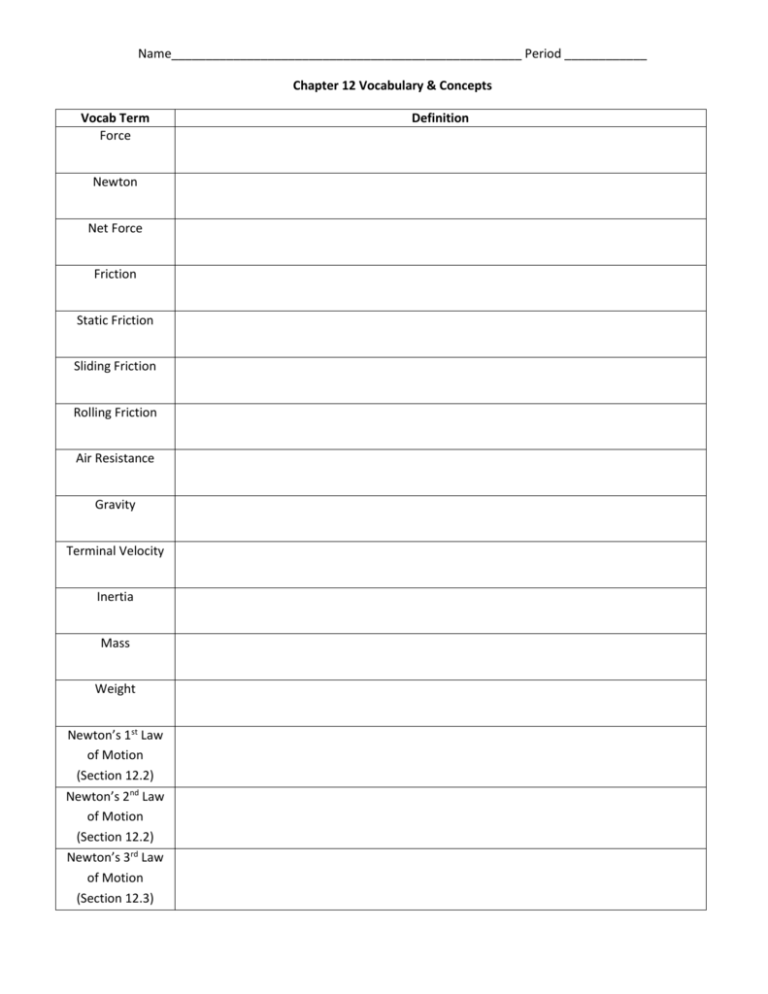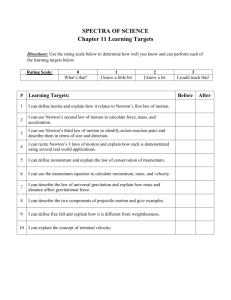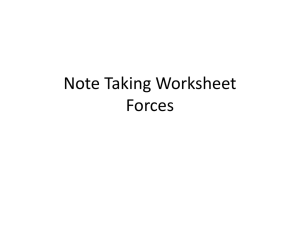Chapter 12 Vocab & Concepts
advertisement

Name___________________________________________________ Period ____________ Chapter 12 Vocabulary & Concepts Vocab Term Force Newton Net Force Friction Static Friction Sliding Friction Rolling Friction Air Resistance Gravity Terminal Velocity Inertia Mass Weight Newton’s 1st Law of Motion (Section 12.2) Newton’s 2nd Law of Motion (Section 12.2) Newton’s 3rd Law of Motion (Section 12.3) Definition Section 12.1: Forces What is a Force? (pages 356–357) 1. A force is defined as a(n) ______________________or a(n) ______________________that acts on an object. 2. True or false? A force can act to cause an object at rest to move or it can accelerate an object that is already moving. _____________ 3. How can a force change the motion of an object that is already moving? 4. Circle the letter of the best answer. What force causes a 1-kg mass to accelerate at a rate of 1 meter per second each second? a. 1 kg/m•s2 b. 1 kg/s c. 1 kg•m d. 1 newton Combining Forces (pages 357–358) 5. The overall force acting on an object after all the forces are combined is the ______________________. 6. How do balanced and unbalanced forces affect the motion of an object? Friction (pages 359–360) 7. True or False? Friction is a force that helps objects that are touching move past each other more easily.___ 8. Circle the letters that identify types of friction. a. rolling b. gravity c. static d. sliding 9. The friction force that acts on objects that are at rest is ______________________ 10. Why is less force needed to keep an object moving than to start the object in motion? 11. Complete the table below about friction forces. Types of Friction Friction Force Static Example Pushing a book along your desk Rolling 12. True or false? Fluid friction is a force that opposes the motion of an object through a fluid such as water. Gravity (page 361) 13. Gravity is a(n) ________________________ force that pulls objects together. 14. True or false? Earth’s gravity acts downward toward the center of Earth. ________________ 15. Describe how gravity and air resistance affect the motion of a falling object. 16. True or false? Terminal velocity is the constant velocity of a falling object when the force of air resistance equals the force of gravity. _______________________ Section 12.2: Newton’s 1st & 2nd Laws Aristotle, Galileo, and Newton (pages 363–364) Match each scientist with his accomplishment. Scientists: A) Aristotle B) Galileo C) Newton _______Italian scientist who did experiments that helped correct misconceptions about force and motion _______Scientist who studied in England and introduced several laws describing force and motion _______An ancient Greek philosopher who made many scientific discoveries through observation and logical reasoning. Newton’s First Law of Motion (pages 364–365) 17. True or false? According to Newton’s first law of motion, an object’s state of motion does not change as long as the net force acting on it is zero. ________________ 18. True or false? The law of inertia states that an object in motion will eventually slow down and come to a complete stop if it travels far enough in the same direction. ____________________ Newton’s Second Law of Motion (pages 365–368) 19. According to Newton’s second law of motion, acceleration of an object depends upon the ____________________________of the object and the ____________________acting on it. Match each term with its description. Description ________A measure of the inertia of an object ________Net force/Mass ________Causes an object’s velocity to change Term A) Mass B) Net Force C) Inertia 20. True or false? The acceleration of an object is always in the same direction as the net force acting on the object. _______________________ 21. True or false? If the same force acts upon two objects with different masses, the acceleration will be greater for the object with greater mass. _______________________ Weight and Mass (pages 368–369) 22. Write the formula used to calculate the weight of an object. 23. True or false? Because the weight formula shows that mass and weight are proportional, doubling the mass of an object will not affect its weight. _______________ 24. On the moon, the acceleration due to gravity is only about one sixth that on Earth. Thus, an object will weigh _________________________on the moon than it weighs on Earth. Section 12.3: Newton’s 3rd Law Newton’s Third Law (page 373) 25. According to Newton’s third law of motion, what happens whenever one object exerts a force on a second object? 26. The equal and opposite forces described by Newton’s third law are called ___________________and ____________________ forces. 27. Circle the letters that identify each sentence that is true about action-reaction forces. A) Newton’s second law describes action-reaction forces. C) Action-reaction forces never cancel. B) Forces always exist in pairs. D) All action-reaction forces produce motion. 28. True or false? Action-reaction forces do not cancel each other because the action force is always greater than the reaction force. _______________ Momentum (pages 374–375) 29. Circle the letter of each factor that affects the momentum of a moving object. a. mass b. volume c. shape d. velocity 30. If two identical objects are moving at different velocities, the object that is moving faster will have _______________________momentum. 31. Your in-line skates are sitting in a box on a shelf in the closet. What is their momentum? 32. True or false? An object with a small mass can have a large momentum if the object is traveling at a high speed. _______________________ 33. Write the momentum formula, including the correct units. 34. Circle the letter of the object that has the greatest momentum. a) a 700-gram bird flying at a velocity of 2.5 m/s b) a 1000-kilogram car traveling at 5 m/s c) a 40-kilogram shopping cart rolling along at 0.5 m/s d) a 300-kilogram roller coaster car traveling at 25 m/s Conservation of Momentum (pages 376–377) 35. What does conservation of momentum mean? 36. True or false? Objects within a closed system can exert forces on one another, but other objects and forces cannot leave or enter the system. ___________________ 37. According to the law of conservation of momentum, what happens to the total momentum of a system if no net force acts on the system? 38. True or false? In a closed system with two objects, the loss of momentum of one object equals the gain in momentum of the other object. ____________________






